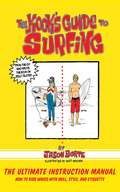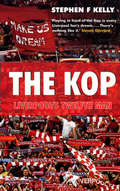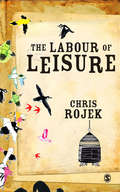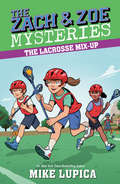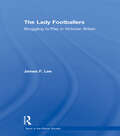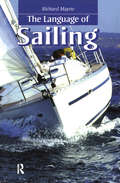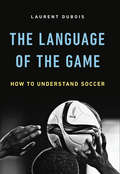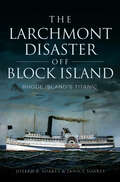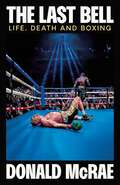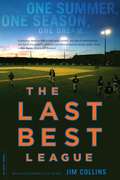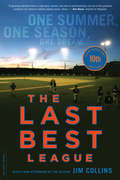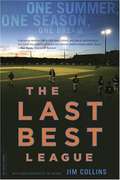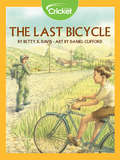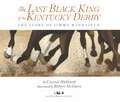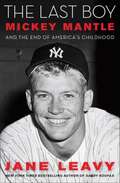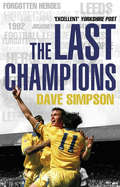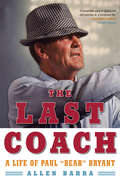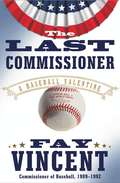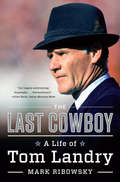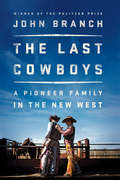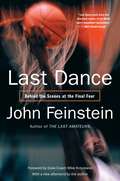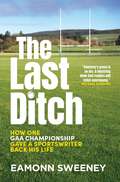- Table View
- List View
The Kook's Guide to Surfing: The Ultimate Instruction Manual: How to Ride Waves with Skill, Style, and Etiquette
by Jason Borte Matt BrownMove over, dude! The Kook's Guide to Surfing shows what it means to be a real surfer. This clever, often hilarious guide shares with kooks (those guys on surfboards who just don't get it yet) the truths and know-how of a lifelong wave-lover. The secret: surfing responsibly and sharing the waves. You don't have to be "too cool for school" to be cool in the water.But surfing like a pro isn't just about courtesy, and neither is The Kook's Guide to Surfing. The ultimate guide to great surfing, it's got tips on choosing the right board for the right wave, stances and paddling, avoiding injuries and staying safe, and--once all that has been mastered--how and where to show off your skills in the big competitions. Other topics include:First lessons and helpful tipsPhysical fitnessTypes of wavesSurf etiquetteBuying surfboardsAn index of the best surf locationsFilled with witty illustrations, a glossary of surfing terminology, and fun "Hey, Kook!" trivia, The Kook's Guide to Surfing will turn even the greenest beginners into knockout surfing pros.
The Kop: Liverpool's Twelfth Man
by Stephen F Kelly'When The Kop is roaring it really is like having a twelfth man out there on the pitch. They're the best fans in the country - by miles.' Jamie CarragherThe Spion Kop is one of the most famous, emotive and atmospheric vantage points in all of sport. The one-time terracing that could 'suck the ball into the net' - in Bill Shankly's immortal phrase - still inspires and intimidates today. Once the home of more than 25,000 swaying, singing, standing Kopites, it's now seated and can hold merely half that number, but its magic still remains.In this fully revised and updated edition, Stephen F Kelly uses eyewitness testimonies from Kopites, policemen, cleaners and referees as well as newspaper reports and the recollections of players and managers to trace the history of this amazing and fascinating stand - each anecdote wonderfully evoking the spirit of the changing times the Kop has experienced.Stirring, emotional and marvellously readable, The Kop is a must for any Liverpool fan and anyone interested in what it means to be a supporter of any football club.
The Labour of Leisure: The Culture of Free Time
by Chris RojekLeisure has always been associated with freedom, choice and flexibility. The week-end and vacations were celebrated as 'time off'. In his compelling new book, Chris Rojek turns this shibboleth on its head to demonstrate how leisure has become a form of labour. Modern men and women are required to be competent, relevant and credible, not only in the work place but with their mates, children, parents and communities. The requisite empathy for others, socially acceptable values and correct forms of self-presentation demand work. Much of this work is concentrated in non-work activity, compromising traditional connections between leisure and freedom. Ranging widely from an analysis of the inflated aspirations of the leisure society thesis to the culture of deception that permeates leisure choice, Rojek shows how leisure is inextricably linked to emotional labour and intelligence. It is now a school for life. In challenging the orthodox understandings of freedom and free time, The Labour of Leisure sets out an indispensable new approach to the meaning of leisure. Chris Rojek is Professor of Sociology and Culture at Brunel University. In 2003 he was awarded the Allen V. Sapora Award for outstanding achievement in the field of leisure studies.
The Lacrosse Mix-Up (Zach and Zoe Mysteries, The)
by Mike LupicaThe sixth installment of New York Times bestselling author Mike Lupica's Zach and Zoe Mysteries--a sports-themed chapter book mystery series perfect for fans of Cam Jansen!There's nothing eight-year-old twins Zach and Zoe Walker love more than playing sports and solving mysteries. And when those two worlds collide . . . well, it doesn't get any better than that. In this sixth installment Zach and Zoe join the Middletown Elementary lacrosse club. But a day after their first game, a mystery presents itself: the netting on one of the school's lacrosse sticks is torn through. Ms. Moriarty says the equipment is just old and worn, but the twins think it might be something else. They decide to investigate, and when the clues start coming together, they realize solving the mystery is only the first piece of an even bigger surprise.Once again, bestselling author Mike Lupica charms his youngest readers yet with a sports-loving detective duo who can swing for the fences and catch the culprit in one fell swoop. With a recipe equal parts sports and mystery, the Zach and Zoe Mysteries break fresh ground for an author who has been called the greatest sportswriter for kids.
The Lady Footballers: Struggling To Play In Victorian Britain (Sport In The Global Society Ser.)
by James F. LeeThis book tells the story of ‘the Lady Footballers’. It covers their 1895 and 1896 tours through the eyes of the largely unsympathetic British press. It explains gender issues of the time, and the financial problems that doomed this experiment. Despite increasing opportunities in sport for British women during the late nineteenth century, virtually every segment of society opposed the idea of women playing football. In 1895, Nettie Honeyball and Florence Dixie formed the British Ladies’ Football Club (BLFC) intending to introduce the game to women and girls as a means of recreation and profit, over 10,000 spectators crowded the football ground in London to watch the BLFC in its first match. Nearly every London newspaper covered the event. These women endured public ridicule. They ignited the gender prejudice of the time, and confronted it head on wearing ‘men’s’ kit, and playing ‘men’s rules.’ Football's mystique was that it was a manly sport for men, thus these women footballers symbolized a paradox: those playing well were gender freaks; those not playing well proved it was a male game. This book was published as a special issue of the International Journal of the History of Sport.
The Language of Sailing
by Richard MayneThere have been many dictionaries explaining to laymen the technical terms of sailing. None of them, until now, has systematically set out to explore their etymology and evolution. The Language of Sailing demonstrates that many of the American and British words in question are derived-- often in complex and controversial ways--from other languages, mainly European. The diction of the sea, in fact, is a huge and hybrid skein, much of it traceable as far back as Sanskrit. It reveals that seafaring knitted Europeans together, sometimes in conflict and rivalry, often also in comradeship, when sailing crews could be as multinational as today's international conglomerates. The Language of Sailing is not intended simply for the entertainment of sailors and scholars. Anyone interested in the literature of the sea will find here an unusual and suggestive resource.
The Language of the Game: How to Understand Soccer
by Laurent DuboisJust in time for the 2018 World Cup, a lively and lyrical guide to appreciating the drama of soccer Soccer is not only the world's most popular sport; it's also one of the most widely shared forms of global culture. The Language of the Game is a passionate and engaging introduction to soccer's history, tactics, and human drama. Profiling soccer's full cast of characters--goalies and position players, referees and managers, commentators and fans--historian and soccer scholar Laurent Dubois describes how the game's low scores, relentless motion, and spectacular individual performances combine to turn each match into a unique and unpredictable story. He also shows how soccer's global reach makes it an unparalleled theater for nationalism, international conflict, and human interconnectedness.Filled with perceptive insights and stories both legendary and little known, The Language of the Game is a rewarding read for anyone seeking to understand soccer better.
The Larchmont Disaster Off Block Island: Rhode Island's Titanic (Disaster Ser.)
by Janice Soares Joseph P SoaresOn February 11, 1907, the steamship Larchmont collided with the schooner Harry Knowlton. Thrown from their bunks, passengers of the Larchmont panicked and ran onto the ship's deck. Haphazardly loaded lifeboats set out only partially full, and shrieks from those left behind were heard in the distance. Nearly 150 passengers were lost that night. The men and women of Block Island courageously aided those in need and dealt with the horrors that washed ashore. Controversy swirled around the conduct of the captain and crew of the Larchmont as investigators tried to determine who was responsible for the collision. Authors Joseph and Janice Soares chronicle one of the greatest disasters in New England's waters.
The Last Amateurs: Playing for Glory and Honor in Division I College Basketball
by John FeinsteinLike millions who love college basketball, John Feinstein was first drawn to the game because of its intensity, speed and intelligence. Like many others, he felt that the vast sums of money involved in NCAA basketball had turned the sport into a division of the NBA, rather than the beloved amateur sport it once was. He went in search of college basketball played with the passion and integrity it once inspired, and found the Patriot League. As one of the NCAA's smallest leagues, none of these teams leaves college early to join the NBA and none of these coaches gets national recognition or endorsement contracts. The young men on these teams are playing for the love of the sport, of competition and of their schools. John Feinstein spent a season with these players, uncovering the drama of their daily lives and the passions that drive them to commit hundreds of hours to basketball even when there is no chance of a professional future. He offers a look at American sport at its purest.
The Last Bell: Life, Death and Boxing
by Donald McRae'The Last Bell takes us on a journey through the last six years in boxing, from 2018 to 2024 as McRae loses his parents and questions why he is still obsessed by the brutality of boxing....The result is exhilarating and terrifying' The Herald, Book of the Month &‘One of the very best writers working today&’ Benjamin Myers, author of The Offing and The Gallows Pole 'Thrilling and raw, this is sport writing at its best' Dina Nayeri, author of The Ungrateful Refugee Donald McRae has been immersed in boxing for fifty years. He has followed fighters around the world and won multiple awards for his writing. But, in recent years, McRae&’s love has waned, as criminality and corruption consume the soul of boxing. In 2018, grieving the death of his sister and with his parents terminally ill, he sought refuge in boxing again – just as Tyson Fury completed an incredible comeback, proving that the ring can still offer exhilaration and redemption. From Fury&’s resurrection to the first undisputed heavyweight champion this century, boxing can be epic and electrifying. It can also be disappointing, as McRae discovers when he documents doping&’s insidious rise or travels to Saudi Arabia where boxing ignores state repression. In The Last Bell, McRae takes us ringside to thrilling bouts with great contemporary champions and fighters as different as Fury, Canelo Álvarez, Oleksandr Usyk, Katie Taylor, Regis Prograis and Isaac Chamberlain. Whether in London or Las Vegas, he shows us what it is like to see joy pour out of a boxer in the dressing room after a magnificent victory or to hold the hand of a fighter being wheeled away on a stretcher after a devastating defeat. As he tries to reconcile the contradictions which lie at boxing&’s murky heart, McRae is unflinching and compelling. McRae helps boxers open up about their doubts and fears and charts the courage of fighters facing ordeals from depression to war. And in telling the heartbreaking story of Patrick Day, he faces death in the ring. The Last Bell is his most powerful and personal book yet, a riveting account of life, death and boxing.
The Last Best League
by Jim CollinsEvery summer, in ten small towns across Cape Cod, the finest college baseball players in the country gather in hopes of making it to "The Show. ” The hopes are justifiably high: The Cape Cod Baseball League is the best amateur league in the world, producing one out of every six major league players, from Nomar Garciaparra and Frank Thomas to Jeff Bagwell and Barry Zito. Jim Collins chronicles a season in the life of one team-the Chatham A’s, perhaps the most celebrated team in the league. Set against the backdrop of a resort town on the bend of the outer Cape, the story charts the changing fortunes of a handful ?of players battling slumps and self-doubt in their effort to make the league playoffs and, more importantly, impress the major league scouts. We learn about everything from the physics of wooden bats and the physiology of elbows to the psychology of slumps and the lure of drugs. In the course of a single dramatic season, with euphoric wins and devastating losses, we come to know the intricacies of the major league scouting network and the rapidly changing profile of major league baseball. In the tradition ofThe Boys of Summer, The Last Best Leagueis about dreams fulfilled and dreams denied, about Cape Cod and the rites of summer, and about the way one small town grows to love a group of young men coming of age in America.
The Last Best League
by Jim CollinsEvery summer, in ten small towns across Cape Cod, the finest college baseball players in the country gather in hopes of making it to "The Show." The hopes are justifiably high: The Cape Cod Baseball League is the best amateur league in the world, producing one out of every six major league players, from Nomar Garciaparra and Frank Thomas to Jeff Bagwell and Barry Zito.Jim Collins chronicles a season in the life of one team-the Chatham A's, perhaps the most celebrated team in the league. Set against the backdrop of a resort town on the bend of the outer Cape, the story charts the changing fortunes of a handful ?of players battling slumps and self-doubt in their effort to make the league playoffs and, more importantly, impress the major league scouts.We learn about everything from the physics of wooden bats and the physiology of elbows to the psychology of slumps and the lure of drugs. In the course of a single dramatic season, with euphoric wins and devastating losses, we come to know the intricacies of the major league scouting network and the rapidly changing profile of major league baseball.In the tradition of The Boys of Summer, The Last Best League is about dreams fulfilled and dreams denied, about Cape Cod and the rites of summer, and about the way one small town grows to love a group of young men coming of age in America.
The Last Best League
by Jim CollinsEvery summer, in ten small towns across Cape Cod, the finest college baseball players in the country gather in hopes of making it to ?The Show. OCO The hopes are justifiably high: The Cape Cod Baseball L"
The Last Best League, 10th anniversary edition: One Summer, One Season, One Dream
by Jim CollinsOriginally published in 2004, The Last Best League chronicles one season in the life of the Chatham A's of the Cape Cod Baseball League, which draws the best college players in the country every summer. Over the past decade, however, baseball's hard truths became evident for Chatham's college stars, who'd had dreams of one day playing in the majors. The final chapter--how those dreams played out--can now be written.In a new afterword written for the tenth anniversary edition, Jim Collins explores an area that sports literature rarely touches: What does it mean to devote your life to an almost impossible goal and not make it? Or, make it only briefly before it slips away? What does a dream look like in retrospect?How does the game look different?
The Last Best League: One Summer, One Season, One Dream
by Jim CollinsThe Cape Cod Baseball League is the best amateur league in the world, producing 1 out of every 6 major league players. This is the story of one season of the Chatham A's.
The Last Bicycle
by Betty X. DavisAs World War II ends, Jacques is delighted to ride his bicycle once again. One day, he finds he may have to give away his bike.
The Last Black King of the Kentucky Derby
by Crystal Hubbard“A biography of Jimmy Winkfield, who battled racism and other obstacles on the road to becoming one of horseracing’s best jockeys and, in 1902, the last African American to win the Kentucky Derby”.
The Last Boy
by Jane LeavyJane Leavy, the acclaimed author of the New York Times bestseller Sandy Koufax: A Lefty's Legacy, returns with a biography of an American original-number 7, Mickey Mantle. Drawing on more than five hundred interviews with friends and family, teammates, and opponents, she delivers the definitive account of Mantle's life, mining the mythology of The Mick for the true story of a luminous and illustrious talent with an achingly damaged soul. Meticulously reported and elegantly written, The Last Boy is a baseball tapestry that weaves together episodes from the author's weekend with The Mick in Atlantic City, where she interviewed her hero in 1983, after he was banned from baseball, with reminiscences from friends and family of the boy from Commerce, Oklahoma, who would lead the Yankees to seven world championships, be voted the American League's Most Valuable Player three times, win the Triple Crown in 1956, and duel teammate Roger Maris for Babe Ruth's home run crown in the summer of 1961-the same boy who would never grow up. As she did so memorably in her biography of Sandy Koufax, Jane Leavy transcends the hyperbole of hero worship to reveal the man behind the coast-to-coast smile, who grappled with a wrenching childhood, crippling injuries, and a genetic predisposition to alcoholism. In The Last Boy she chronicles her search to find out more about the person he was and, given what she discovers, to explain his mystifying hold on a generation of baseball fans, who were seduced by that lopsided, gap-toothed grin. It is an uncommon biography, with literary overtones: not only a portrait of an icon, but an investigation of memory itself. How long was the Tape Measure Home Run? Did Mantle swing the same way right-handed and left-handed? What really happened to his knee in the 1951 World Series? What happened to the red-haired, freckle-faced boy known back home as Mickey Charles? "I believe in memory, not memorabilia," Leavy writes in her preface. But in The Last Boy, she discovers that what we remember of our heroes-and even what they remember of themselves-is only where the story begins.
The Last Champions: Leeds United and the Year that Football Changed Forever
by Dave SimpsonWhen the Leeds United players celebrated winning the championship in April 1992, they had no idea how momentous the occasion was. Manchester United, losers at Liverpool that Sunday afternoon, had now gone 25 years without winning the league. Howard Wilkinson's side, promoted just two seasons ago, could bring back the glory days to Leeds. But Wilkinson would prove to be the last English manager to win the league. In 1992, football changed beyond all recognition.The Last Champions explores the roots of that success and the amazing cast of characters who came together to fashion the triumph. As in his acclaimed book The Fallen, Dave Simpson's quest to catch up with the protagonists of the era, from the visionary Sergeant Wilko, top scorer Lee Chapman and unsung heroes like Mike Whitlow and Carl Shutt (not forgetting Eric Cantona), sees him unearth some extraordinary untold stories.And he finds that The Last Champions were also the last ordinary people to win the league, before the Premier League saw skyrocketing wages, billionaire foreign owners and the dictates of television taking the game away from the fans. It is the brilliantly told story of the end of an era.
The Last Coach: A Life of Paul "Bear" Bryant
by Allen BarraThe explosive biography of the greatest college football coach in history. When Paul William "Bear" Bryant died on January 26, 1983, it was the lead story on the all three networks' evening news. New York City newspapers reported his death on their front pages. Three days later, America watched in awe as an estimated quarter of a million mourners lined the fifty-five mile stretch from Tuscaloosa to a Birmingham cemetery to pay their respects as his three-mile long funeral cortege drove by. Bryant's passing was noted with the kind of reverence our country reserved for statesmen or military leaders, though Paul "Bear" Bryant had insisted for much of his life that he was "just a football coach." For millions he was much more, he was the greatest coach the game ever saw, the heir to the tradition established by Knute Rockne. He took his Alabama Crimson Tide teams to an unmatched six national championships. But to the players, journalists and fans whose lives he touched in his more than half a century as a player and coach, he was the last symbol of values that transcended football—courage, discipline, loyalty, and hard work. To his critics, Bryant represented the dark side of big-time college football—brutality, fanaticism and blind adherence to authority. The real Bear Bryant was far more complex than either his admirers or detractors knew. While maintaining a public friendship with Alabama governor George Wallace, he continually sought ways to undermine the governor's segregationist policies, finally forcing a legendary football game in Birmingham with the University of Southern California that opened the floodgates to the integration of football at the University of Alabama, including its coaching staff. Old fashioned in his politics, he was nonetheless an admirer of Robert Kennedy, whom he planning to vote for in 1968. Allen Barra's The Last Coach traces Paul Bryant's rise from a family of truck farmers to recognition as the most successful and influential coach in the game's history. Through it all, Bryant's influence has not only endured but prevailed as his former players and assistants continue to define the best in not only college but professional football. A USA Today and Washington Post Best Sports Book.
The Last Commissioner: A Baseball Valentine
by Fay VincentOn a beautiful July morning in 1991, three men gathered in a hotel suite for an informal breakfast and conversation. The discussion ranged widely over events and characters of the past, famous names and fabled accomplishments flowing along with the coffee and juice. Two of them, Ted Williams and Joe DiMaggio, were the ultimate symbols of athletic glory for generations of American men. The third man, Fay Vincent, was living a dream, sitting with and asking questions of his boyhood heroes. Fay Vincent never set out to be the commissioner of baseball. He got into the game alongside his good friend A. Bartlett Giamatti, as deputy commissioner, when Giamatti was named to the sport's highest office in 1989. They spent their first spring and summer dealing with Pete Rose's gambling, and Vincent's legal expertise complemented his friend's moral thunder. But that was to be their only season working side by side, as Bart Giamatti's heart gave out just days after the announcement of the Rose suspension. Vincent found himself the only logical candidate to fill a position as guardian of the best interests of the game he loves. In The Last Commissioner: A Baseball Valentine, Vincent takes us along for the ultimate fan's fantasy camp. As commissioner, he got to talk baseball with the likes of Yogi Berra, Larry Doby, Warren Spahn, Ernie Banks, Eddie Lopat, Whitey Ford, and Henry Aaron. He brought his legal training to bear on the delicate issue of whether Roger Clemens uttered the magic word that would justify his being tossed out of a playoff game (and it's not the word you think). He was one of the few outsiders at the annual Hall of Fame banquet for the new inductees and their immortal peers, where he watched, amazed, as Johnny Mize demonstrated to Ralph Kiner his method of hitting an inside pitch -- a piece of advice from forty years past. And he brought equal respect and attention to the greats of the Negro Leagues, listening to the gracefully told stories of Joe Black and Buck O'Neil, slowly learning how Slick Surratt earned his nickname, hearing Jimmie Crutchfield give as good a definition of a well-lived life as we will ever know. Vincent shares these stories and more: his high regard for umpires, instilled in his youth by his father, an NFL official and respected local ump; his close relations with the Bush family, forged in a summer spent working in the oil fields with his schoolmate Bucky Bush, the 41st president's brother (and 43rd president's uncle); his unusual experiences with the relentless George Steinbrenner, including the famous meeting where the Yankees owner was facing a two-year suspension and plea-bargained it down to a lifetime ban. Vincent also gives his candid views on the state of baseball today, firm in his belief that the game will survive its current leadership and even prosper. Through it all, Vincent's deep love of baseball shines through. His most remarkable accomplishment as commissioner may have been to emerge from the office with his fandom intact. The Last Commissioner is truly a valentine to the game, written with the insight and vision that comes from the lofty perch of the ultimate front-row seat.
The Last Cowboy: A Life of Tom Landry
by Mark Ribowsky"An eloquent, honest tribute to a sports genius." --Publishers Weekly, Best 100 Books of 2013 As the coach during professional football's most storied era, Tom Landry transformed the gridiron from a no-holds-barred battlefield to the highly-technical chess match it is today. With his trademark fedora and stoic facade, he was a man of faith and few words, for twenty-nine years guiding "America's Team" from laughingstock to well-oiled machine, with an unprecedented twenty consecutive winning seasons and two Super Bowl titles. Now, more than a decade after Landry's death, acclaimed biographer Mark Ribowsky takes a fresh look at this misunderstood legend, telling us as much about our country's obsession with football as about Landry himself, the likes of whom we'll never see again.
The Last Cowboys: A Pioneer Family In The New West
by John BranchA gripping portrait of one family’s gamble that rodeo and ranching are the future of the West—and not just its past. For generations, the Wrights of southern Utah have raised cattle and world-champion saddle-bronc riders—some call them the most successful rodeo family in history. Now Bill and Evelyn Wright, parents to 13 children and grandparents to many more, find themselves struggling to hang on to the majestic landscape where they’ve been running cattle for 150 years as the West is transformed by urbanization, battered by drought, and rearranged by public-land disputes. Could rodeo, of all things, be the answer? In a powerful follow-up to his prize-winning, best-selling first book, New York Times reporter John Branch delivers an epic and intimate family story deep in the American grain. Written with great lyricism and filled with vivid scenes of ranch life and the high drama of saddle-bronc competition, The Last Cowboys chronicles three years in the life of the Wrights, each culminating in rodeo’s National Finals in Las Vegas. Will Bill and Evelyn be able to hold the family together as rodeo injuries pile up and one of their sons goes off on a religious mission? Will their son Cody, a two-time world champion, make it to the finals one last time—and compete with his own son? And will the younger generation—Rusty, Ryder, Stetson, and the rest—be able to continue the family’s ways in the future? This is a grand and compelling work of reporting that, like Buzz Bissinger’s Friday Night Lights, offers deep insight into American ritual and tradition. And in telling the Wright family’s story, from branding days to rodeo nights to annual Christmas gatherings, Branch captures something vital of the grit, determination, and integrity that fuel the American Dream. An unforgettable book by one of the finest reporters of our time, The Last Cowboys is a moving tribute to an American way of life.
The Last Dance: Behind the Scenes at the Final Four
by John FeinsteinThere is no event in sports quite like the Final Four. John Feinstein explores what it means to a school, a coach, and a player to be in the Final Four or even at The Final. There are the moving stories of players and coaches who thought they'd never make it to college basketballs final weekend, the spectacular triumphs of the winning teams, and the heartbreaking defeats for those who missed the cut. Feinstein also brings us inspiring and dramatic stories from the people behind the scenes: from the officials and referees to the scouts and ticket-scalpers. With the unflinching eye of a seasoned reporter and the remarkable skill of a true storyteller, Feinstein exposes the driving forces behind one of the most revered events in American sports.
The Last Ditch: How One GAA Championship Gave a Sportswriter Back His Life
by Eamonn Sweeney"Sweeney's prose is on fire. A blistering book that readers will relish enormously." MICHAEL HARDING"A cracking read ... a championship season as redemption song." MICHAEL CLIFFORD"All the tension of a tight knockout encounter ... one of the books of the year." MIKE McCORMACKIn the summer of 2024, sports columnist Eamonn Sweeney set out to follow the All-Ireland championships around the country, retracing footsteps he'd first laid down in his 2004 bestseller The Road to Croker. But there was one big problem. For many years, he had struggled with a crippling travel phobia that left him largely confined to his hometown in West Cork. To fulfil his publishing contract, he had to face his deepest fears.The Last Ditch is a story about mental health, hidden shame and a life-changing moment in a remote train station. It's about a hurling championship which may have been the greatest ever played and a football championship which definitely was not. It's about unlikely triumphs, remarkable renaissances, shocks, cliff-hangers and heartbreaks on the pitch. Off the field, it is the story of one man's embrace of a changing Ireland as he takes back his life. Both an unforgettable sports odyssey and a revelatory personal account, The Last Ditch is a celebration of resilience, the healing power of connection and the unifying spirit of the GAA.
